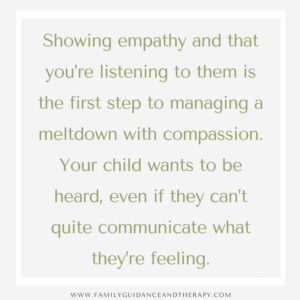To someone looking in from the outside, an autism “meltdown” might look like a child throwing a temper tantrum, but what’s going on is often much more complex.
If you’ve cared for a child with autism, you might know that a child going through a meltdown has different triggers, motivations, and needs than a child having a tantrum.
To know what is going on with your child when they’re having a meltdown, and how to help them, you first have to understand what a meltdown is.
Autism Meltdowns: What Are They?
A meltdown in an autistic person is a reaction to sensory, emotional or other overwhelm.
When an individual feels overwhelmed and can’t express themselves, a meltdown can happen. In children, this often manifests as crying or screaming or even physical responses such as kicking, biting or scratching.
These types of physical reactions are different from stimming, but stimming can happen right before a meltdown.
People with autism often have intense sensory sensitivities to light, sounds, and more.
So when a child with autism is triggered by bright or flickering lights, a noisy classroom or even certain tastes or textures, a meltdown can happen.
Meltdowns can also be triggered by changes in routine or other unexpected changes, or simply because, with the communication challenges that often come with autism, the child can’t express what they need or want.
Meltdowns vs. Tantrums
Although they might look similar, there is a key difference between a meltdown and a tantrum: a child throwing a tantrum can control themselves; a child having a meltdown cannot.
A child having a tantrum is typically trying to get something they want through crying and screaming or other disruptive behavior.
It is a choice, while a meltdown is a physical response that can not be controlled.
Related Reading: Raising Neurodivergent children to live lives of purpose
The Importance of Handling Meltdowns with Compassion
Meltdowns don’t just happen to autistic children--they happen to autistic adults, too.
Meltdowns in adults might look a little different and individuals typically can recognize what is happening and try to calm themselves down, but it still is outside of their control.
Lyric Holmans, the autistic self-advocate behind the internationally recognized neurodiversity lifestyle blog Neurodivergent Rebel, says:
“A meltdown is beyond an autistic person’s control. Their brain is overwhelmed & can’t take anymore. They might start crying or fall to the floor because they’re just mentally done - completely overwhelmed.
The fight, flight, freeze response has been triggered, almost like a panic attack kind of a feeling. It’s a horrible feeling.”
The fact that people with autism continue to have meltdowns into adulthood shows that they are not just childish “temper tantrums” but a normal (if distressing) part of life for many autistic people.
That’s why it’s so important that we handle them with compassion, especially when they happen to our children.
Compassion shouldn’t be limited to our children experiencing autistic meltdowns. All of our children deserve compassion, even when they are throwing a temper tantrum.
We don’t have to give in and give a child throwing a tantrum what they want, but we can approach the situation with empathy, compassion, and understanding.
How to Approach a Meltdown with Compassion
Make Sure Your Child Feels Safe
Making sure your child feels secure and loved can mean gently talking them through their meltdown, but children experiencing meltdowns are often so overwhelmed that they can’t fully understand or respond to what you’re saying to them.
It’s not willfulness, it’s beyond their control.
Talking might not work, but just being with your child and sitting quietly with them, can let them know you are there for them. It may even calm them.
It’s very important to remain calm and to make sure your face, tone of voice, and words relay calm and concern for your child, not anger or frustration.
Show Empathy
Sometimes we don’t feel compassion for others, even our kids!
It’s a normal part of being human to feel angry, annoyed, or just fed up sometimes, but it’s important that, despite those feelings, we try to do what’s best for our children.
That includes handling meltdowns with compassion.
This means putting empathy first. If you can put yourself in your child’s shoes, and really understand what they’re going through, you can handle a meltdown with compassion.
You might not be able to do this immediately, and that’s ok! Learning what your child’s triggers are, what happens when those triggers occur, and what you can do to help takes time!
What will help you the most is learning who your child is, what their unique personality is like, and how that is connected to their triggers and what calms them.
We never know everything about a person, even our own children. We’re always learning, and what we learn helps to shape how we interact with each other.
A concern for many parents of autistic children is how to help them to develop, learn new things, and be as successful in life as possible--and how to do all this without forcing them to “fit in” or losing their own unique personality.
Managing meltdowns is no different. We want our children to feel that they are heard, they are cared for, and that they are accepted for who they are.
This is why empathy is so important. We want to show our children that we understand and that we care.
Showing empathy and that you’re listening to them is the first step to managing a meltdown with compassion. Your child wants to be heard, even if they can’t quite communicate what they’re feeling.
Take Action
After you’ve assured your child you understand, you’re listening and that you care, you can take a few steps to manage a meltdown.
Every person with autism is different, so there may have to be some trial and error to determine what works best for your child.
Some methods include:
- Keeping a “meltdown kit” on hand that includes sensory calming devices like fidget toys, noise-canceling headphones, a weighted vest or whatever works for your child’s triggers. Do not try to force these devices on your child, but let them know that they are available if they want them.
- Use a low, quiet voice to speak to your child. Speak slowly. It sometimes takes a bit longer for people with autism to process words, especially when upset.
- Asking your child simple questions about what they might need like “Do you want your headphones?” Keep your sentences short and simple. Too much talking can make things worse. Do not mention the meltdown.
- Give your child space. While reassuring your child that you’re there for them is important, they could also need space. If you are at home or in another situation where you feel that you can leave your child alone for a little while, consider doing so.
Looking for ways to help your child self-regulate and remain calm? This is what we do with clients.
Preventing Meltdowns
You will eventually learn most of your child’s triggers and may be able to avoid a meltdown.
If you can help your child to calm or redirect, or if possible, simply avoid their triggers altogether, you can minimize meltdowns.
Some ways to prevent meltdowns include:
- Knowing and avoiding your child’s sensory sensitivities, such as bright lights, certain textures or smells, or loud noises.
- Knowing and sticking to (when possible) your child’s daily routine. Whenever possible, prepare your child for any changes in schedule, meals, etc.
- Distract your child with their favorite things: a phone or tablet, a beloved toy or snack, or a song or video that your child loves.
- Teaching your child relaxation techniques, such as breathing deeply, meditation or counting from 1 to 10. These techniques should not be taught during a meltdown, but rather another time when the child can actually learn them. Going forward, your child may use the relaxation techniques they’ve learned to help to prevent and manage meltdowns.
Teaching Our Children Compassion
Meltdowns and tantrums are distressing for everyone involved, but a situation like this can be an opportunity to teach your child what it’s like to receive compassion--and how to practice compassion themselves.
Remaining calm and not showing anger or frustration, but instead empathy and love, during a meltdown teaches our kids that this is the correct response to a frustrating and upsetting situation.
“Meltdowns are a horrible thing to experience,” says Ashlea McKay, an autistic writer. “No matter how uncomfortable, distressed or inconvenienced you may feel, the autistic person having the meltdown is suffering on a whole other level.”
We want our kids to show compassion, not only for others, but for themselves.
We want them to know that we all have struggles, but they can be managed by preparing, staying calm, and practicing compassion.

